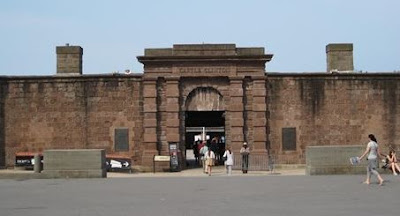Iwalked New York City's Battery Park Castle Clinton - Castle Clinton was an American fort built in 1811 in preparation for the War of 1812. It was designed by the John McComb, Jr. who is also thought responsible for the St. Elizabeth Ann Seton Shrine. It was the last of five forts built in New York. Castle Clinton’s brownstone walls were largely erected through the hard efforts of volunteers which largely included students from Columbia College.
Castle Clinton was not the first fort located near this spot. Shortly after the Dutch first arrived and began settling in this area in 1625 they began to build the first fort, Fort Amsterdam, in 1626 to protect their settlement. This fort was later renamed in 1687 to Fort George after the British began to take over. The mounted cannons at Fort George in this area provided the nickname “The Battery” for the park in which Castle Clinton is located. Approximately 100 yrs later that original fort was finally destroyed and used for landfill in expansion of The Battery. The site of this historic fort is now the site of the Alexander Hamilton U.S. Custom House.
Getting back to Castle Clinton, it was originally named the West Battery before being renamed in 1815 to then New York City mayor (and later New York governor) DeWitt Clinton. The fort and its 28 guns were officially decommissioned in 1824 after never firing a single shot. The former fort was transformed and leased by the city to become a private theater under the name Castle Garden. For thirty years, until 1855, the venue was the site of popular shows as well as serving as a beer garden. It was during this period in 1850 that P.T. Barnum introduced the United States to the Swedish soprano Jenny Lind.
In 1855 the U.S. government took over the property and used it for a period as the predecessor to Ellis Island for immigration processing. It would serve this function until 1890 when responsibility was officially shifted to Ellis Island. During this period of 35 years, approximately 8 million people were processed for arrival to the United States including Harry Houdini.
In 1896, Castle Garden took on yet another life as it housed the New York Aquarium. The Aquarium resided here until 1941 where the building remained vacant for a few years before serving in its current capacity as the ticket offices for the Ellis and Liberty Islands.
You can walk around inside Castle Garden for free today. Inside are numerous historical plaques and such where you can read more about the history of this site. If you are interested in catching one of the ferries to Liberty and/or Ellis Island, please note that it is recommended you purchase tickets in advance as they do sell out. Both islands are popular for obvious reasons. Per the National Park Service website, some four million visitors were recorded to these sites in 2009.
 |
| Castle Clinton |
Getting back to Castle Clinton, it was originally named the West Battery before being renamed in 1815 to then New York City mayor (and later New York governor) DeWitt Clinton. The fort and its 28 guns were officially decommissioned in 1824 after never firing a single shot. The former fort was transformed and leased by the city to become a private theater under the name Castle Garden. For thirty years, until 1855, the venue was the site of popular shows as well as serving as a beer garden. It was during this period in 1850 that P.T. Barnum introduced the United States to the Swedish soprano Jenny Lind.
In 1855 the U.S. government took over the property and used it for a period as the predecessor to Ellis Island for immigration processing. It would serve this function until 1890 when responsibility was officially shifted to Ellis Island. During this period of 35 years, approximately 8 million people were processed for arrival to the United States including Harry Houdini.
In 1896, Castle Garden took on yet another life as it housed the New York Aquarium. The Aquarium resided here until 1941 where the building remained vacant for a few years before serving in its current capacity as the ticket offices for the Ellis and Liberty Islands.
You can walk around inside Castle Garden for free today. Inside are numerous historical plaques and such where you can read more about the history of this site. If you are interested in catching one of the ferries to Liberty and/or Ellis Island, please note that it is recommended you purchase tickets in advance as they do sell out. Both islands are popular for obvious reasons. Per the National Park Service website, some four million visitors were recorded to these sites in 2009.
- Website: http://www.nps.gov/cacl/index.htm
- Address: Battery Park, New York City, NY
- Cost: Free.
